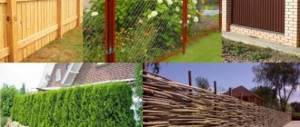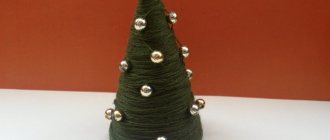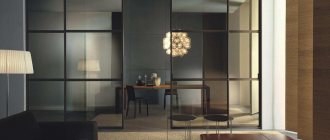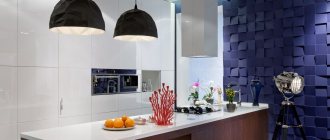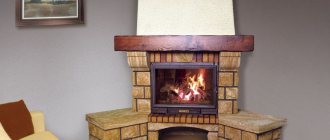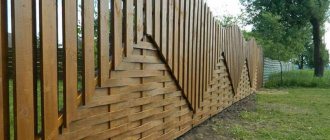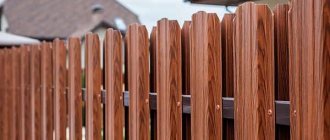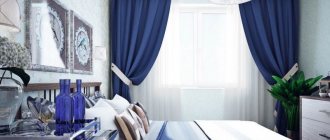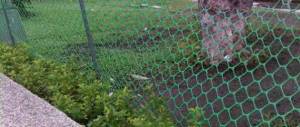A neatly designed summer cottage or local area of a city or country house contains many decorative elements.
Stylish and modern zoning may include the presence of small fences, as a compositional addition to the overall idea of landscape design and architectural composition.
The proposed photos of a decorative fence are already implemented ideas and solutions that increase the aesthetics of the site design.
To diversify the arrangement of the local area, they can be used in any zone when dividing the total area and as a division of space during zoning.
What functions do small fencing structures perform?
Before building a fence with your own hands, you need to decide on its intended purpose and conditions for further use.
The need to arrange a decorative fence may be dictated by the concept of subject zoning, while a self-installed structure can perform several functions at once:
- fixing the boundaries of the site allocated during zoning or design;
- protect garden plantings and flower beds, ensuring their complete or partial isolation;
- creating and maintaining an atmosphere of comfort and coziness, emphasizing the decorative design;
- performing an aesthetic function and decorating designated functional areas on the site.
Fences made from standard building materials or improvised means should combine decorativeness and functionality.
Some models look original and attractive, successfully combining with the composition of the arrangement and aesthetic design of the entire territory, dividing it into certain zones.
Choosing decorative fences for flower beds: materials and configurations
Many people think that fencing for flower beds serves only a decorative purpose. But, in fact, this product is very useful in practical terms. For example, you can’t do without a fence when the flower garden consists of tall and branchy plants with thorns. In this case, the product must protect the flowers so that children or animals do not accidentally get injured by their thorns.
Wooden fence for rose garden
Mini fences for flower beds are also necessary when perennials with an extensive root system grow in the flower garden. For example, if one of the inhabitants of a flower bed is a fern, over time its roots will spread beyond the territory. To prevent this from happening, you can block the plant's root system using a dug-in fence. As a rule, flat barriers, such as plastic fences, cope best with this task.
Decorative fences for flower beds made of plastic
Plastic decorative fences for flower beds photo
If we are talking about flower beds raised above the ground, then the fence should keep the soil from falling out. Lightweight structures are unlikely to cope with this task, so you should give preference to fences made of dense material - metal, stone, etc.
Fences for flower beds photo
Beautiful fencing for flower beds made of stone
And, of course, a decorative fence for a flower bed should fit harmoniously into the landscape design of the garden. If the site contains objects such as metal benches, arches, pergolas, etc., elegant wrought iron fences for flower beds will look very beautiful against their background. Moreover, products made from this material are distinguished by a huge variety of designs.
Original wrought iron fences for flower beds
Forged fence in the shape of flowers for a flower bed
Fencing for flower beds photo
If the landscape design of your garden is designed in the style of naturalism and naturalness, choose fences made of wood or materials that imitate wood. Fences made of natural or artificial stone will also look good in such areas.
Decorative fences for round flower beds photo
Decorative fences for round flower beds photo
Decorative fencing for flower beds made of stone
As for the height of the fence for the flower bed, it primarily depends on the height of the flower bed. For miniature decorative flower beds, mini fences with a height of no more than 7-8 cm are suitable.
If the flower garden fencing simultaneously serves as a border or plot divider and garden path, its height should be at least 10 cm. In this case, you need to give preference to durable and stable materials, for example, dense plastic, brick, stones, etc.
For rose gardens and tall flower beds, fences 35-40 cm high are suitable, because... Animals will be able to jump over lower structures.
It may seem that high fences will hide the beauty of plants. To prevent this from happening, give preference to “transparent” fences - picket fences, forged elements, etc.
White wooden fence for fencing flower beds
White wooden fence for flower beds and flower beds
Self-construction: requirements for arranging fences
Small decorative fencing structures have their own operating characteristics and practical characteristics.
To implement the chosen project, you can use different materials, adhering to a certain set of requirements and standards for the arrangement of the dacha or house plot on which they are located:
- ease of processing and installation of fencing in whitewashed areas;
- easy maintenance and the ability to replace worn structural elements;
- increased decorativeness and decoration of the entire site in a single style;
- expression of taste and enhanced artistic value with practicality.
For decorative fences, the concept of combining practicality and aesthetics, with design in different styles, is most often used.
A decorative cart is a beautiful option for landscape decoration, see options and ideas on how to make a cart with your own hands (photos and videos)
- A beautiful decorative mill is a way to decorate your site in an original way without much effort, see how to make a mill with your own hands!
Creating a rock garden - features of application in landscape design. 145 photos of the most beautiful design elements
Not tall and fairly durable structures are characterized by high decorativeness and ease of maintenance; they are used to specifically divide an area into certain zones.
Wood – classic is immortal
Wood remains the most popular material for making a garden fence. It is easy to work with, inexpensive and lasts a long time with proper care. There are many design options for wooden fencing. Thick boards can make a solid fence, thin slats can make an impressive lattice fence, and even untreated natural branches can serve as a stylish fence.
Wooden space dividers
Plank fence - traditional style
A fence made of wooden pickets is a real classic in the design of a personal plot. It can be tall - for fencing the entire area, or doll-sized - for decorative purposes. Depending on the overall style of the landscape, you can use a wooden fence around the garden in different ways.
The traditional color for painting a fence has been and remains white. This type of fencing sets off the vibrant colors of garden plants, fits into any style and looks unobtrusive.
White color is always in fashion
If you want to decorate your flowerbed exclusively with natural materials, adhering to an eco-style, there is hardly anything better than untreated wooden boards. For best results, use old wood.
This type of fencing will appeal to those who are tired of glossy vinyl fences.
If you approach the construction of the fence from the other side and place the boards horizontally rather than vertically, you can get such a durable and stylish fence. To give it a finished look, a ridge or parapet strip is installed on top. This way the fence will not only be beautiful, but also protected from the harmful effects of precipitation.
Wooden fencing made of horizontal boards
Wooden fencing
Wooden mesh is an excellent fencing option, especially if it is decorated with climbing plants. To build such a fence, wooden posts are installed on which a section of slatted lattice rests. Wooden lattice is sold in hardware stores, but you can also make it yourself.
Fences and garden railings made of wooden lattice are perfect for:
- fencing the entire site;
- fencing a separate flower bed;
- fencing a gazebo or recreation area;
- as a free-standing decorative element for vertical gardening (trellis).
The grid with cells rotated 45 degrees looks elegant and light. Climbing plants look good on such a fence: climbing roses, clematis, wisteria. If the slats are perpendicular, the fence looks completely different. Solid pillars and a strict wooden mesh will well complement the compositions of sculptures from evergreen shrubs and a labyrinth of hedges.
A fence with high sections does not look too bulky
Strict wooden lattice without frills
Concrete, brick and stone
The most stable and visually attractive decorative concrete fences look quite original and elegant on the site.
For brick and stone fences, monumental structures should be avoided, which can overload the overall composition, so fences are selected with partial viewing.
- We are building an artificial hill on a summer cottage - construction technology and features of application in landscape design (135 photos)
- Do-it-yourself mailbox - a detailed description of how and what to make a beautiful and convenient mailbox for letters (80 photos and videos)
Flowerbed made from bottles - a master class in making original flowerbeds. 120 photos of decorating a flower bed using plastic
Wood and wood materials
A small fence made of decorative wood may differ in width and arrangement of wooden slats.
Horizontal and vertical or diagonal structures look very attractive and can be used to decorate a garden or green spaces, to enclose playgrounds and play areas.
Fence for a flower bed made from scrap materials
The flower plot fencing can be made using natural wood. The florist goes well with garden furniture or other elements also made of wood. In addition, the material is completely environmentally safe, without harming others or the soil. There are many options, there are many options for using such fencing.
Mesh, welded and chain-link
Mesh fencing structures are perfect for planting climbing plants and forming hedges.
Grapes and climbing roses, cucumbers and even melons are actively used to decorate such structures, becoming green fences, but mesh fences require supports.
Forged metal rods
Using decorative fence posts made from different materials, they can be combined with other structural elements.
Forged fences are highly practical and optimally decorative, but if there are children and animals on the property, you need to take care that there are no sharp corners.
Garden furniture - tips on selection, use and care. Rules for placement and nuances of choosing material (105 photos)
Sun loungers for the garden - the best models and options for their use. 110 photos of the best models of the 2019-2020 season
Do-it-yourself figurines for the garden: options for figures, choice of material, useful tips. Step-by-step master class on how to make a pink flamingo from plastic bottles and a gnome from plaster
Decorative metal fencing for flower beds
To create an elegant, sophisticated fence, you should purchase metal elements. Fences with forging elements look especially luxurious. It is possible to make such a fence yourself only if you have experience in welding work, as well as the necessary tools. Forged fences can serve as decoration for a flower garden. The main thing is to do all the work correctly.
First you need to decide on the appearance of the fence and its size. A wrought iron fence can perform not only a decorative, but undoubtedly functional task. This design is characterized by high strength and durability. To extend its service life, it is imperative to protect the metal from the harmful process of corrosion. Easy to perform using special surface treatment.
Metal fences go well with wooden or stone elements located throughout the garden.
Available materials
A simple and original fence for a flower bed can be made from plastic bottles and scraps of PVC pipes, using unusual sketches.
To decorate them, you can use painting methods and other materials, such as twine; fences with decorative ornaments and additional decoration look beautiful.
Photo of a decorative fence with your own hands
Did you like the article? Share 
0

